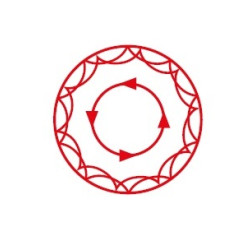Polishing machines
Basically, there are two different types of polishing machines:
Rotary polishers are all-around machines suitable for all polishing tasks. They are particularly preferred for sanding tasks that require a minimum amount of material removal. The attached polishing pad performs a concentric rotary motion, spinning only around its own axis. The speed range is usually adjustable between 300 and 3000 RPM. Machines in the price range of 70-150 euros are sufficient for beginners, although the included accessories should be replaced. Professionals, on the other hand, should opt for a more expensive machine designed for continuous use.
Random orbital polishers are usually designed for finishing work, such as processing high-gloss polishes and sealants. The polishing pad moves in an eccentric pattern, both rotating around its own axis and shifting by a certain distance (the throw) relative to the central axis. The usual throw is 5-8mm, but in some cases (Rupes), it can be 15-21 mm. Due to the throw and the resulting maximized uniform performance, random orbital polishers have slight advantages in finishing, especially for professional detailers in continuous commercial use.
Random orbital polishers also differ in technical aspects:
Basic, inexpensive entry-level devices achieve the random orbital motion by using a screw-in attachment for the polishing pad that is eccentrically offset from the central axis by the throw distance. The required smooth operation is achieved through a counterweight. For semi-professional hobby use, this technique is entirely adequate and effective.
High-quality random orbital polishers designed for professional continuous use are equipped with a forced rotation mechanism. In this case, the polishing pad is set into the eccentric motion through a special gearbox, resulting in significantly higher speed stability under load. For finishing work on more than 5 vehicles per week, this technology is indispensable.
Which machine should you choose?
When faced with the choice, purchasing a rotary machine is generally recommended as it is more versatile. In particular, removing car wash scratches and light surface defects, such as faded areas and holograms, is much more effective with a rotary device. The often-cited argument that using a rotary polisher can damage the paint or cause damage to the clear coat is entirely unfounded with proper usage. Damage usually arises from using low-quality, unsuitable, or even dirty polishing pads. When using a new, clean polishing pad and a fine polishing compound like Menzerna MC2500, you can safely and harmlessly polish all removable defects from your paint without worrying about removing too much of the 40-60-micrometer-thick clear coat layer.
For further understanding, you can watch the easily understandable video from FLEX Tools.


